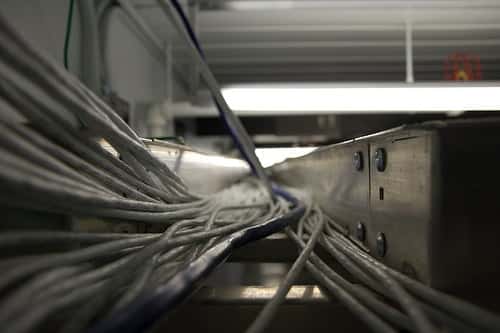 One of the most frequently asked questions our Measurement Experts field is “How far away can my sensor be?” And the most popular answer we give is “What kind of signal does your sensor use?”
One of the most frequently asked questions our Measurement Experts field is “How far away can my sensor be?” And the most popular answer we give is “What kind of signal does your sensor use?”
Because it really is as simple as that: the allowable distance between your sensor and control equipment is almost entirely dependent on the signal type of your sensor. There are, of course, other physical factors, like resistance and voltage, but the way they limit distance is different for each signal type.
So, how far can your signal go?
The theoretical (emphasis on “theoretical”) distance limit for a 4-20 mA sensor depends on the load resistance limit of the transmitter/receiver. Typically, a 4-20 mA transmitter will have a load limit between 500Ω and 1000Ω.
Alright. What makes up load resistance? For a 4-20 mA sensor circuit, it’s pretty much just the sensor and the cable. And since we’re primarily interested in cable length, let’s just look at the resistance of the cable.
Electricity, for reasons known only to itself and exceedingly complicated math, prefers to flow on the outside of a conductor, so smaller conductors have a greater resistance (smaller surface area for the current to fight through). For example, copper cables size 18 AWG have a resistance of 6.385 Ω/kft (ohms per thousand feet), while 22 AWG copper cables have a resistance of 16.14 Ω/kft, almost 3 times greater than the 18 AWG cables.
So what does that mean for cable distance? To pull a number out of the air, let’s say the maximum resistance your cables can add to the circuit is 250Ω. For 22 AWG wire, with the aforementioned 16.14 Ω/kft, it will take 15.5 kft to reach 250Ω. Yes, that’s 15,500 feet. You were planning on having your sensor be within 3 miles of the transmitter, right?
DC Voltage output sensors are the wild card in the maximum distance game. As we’ve looked at in other posts, DCV sensors are sensitive to both distance and noise because the signal being measured is voltage. So Ohm’s Law (V = I * R, Voltage equals Current times Resistance) is not only descriptive, it is instructive: the resistance in the circuit increases with circuit length, which increases the voltage dropped, or lost, along the way. Whether or not the amount of voltage drop is acceptable depends on the amount of error it introduces.
Let’s take a look at a couple of scenarios so we can see how this works. First, for a sensor pulling 10 mA located roughly 300 ft. from its controller, we’ll check the voltage drop using 22 AWG cable and 18 AWG cable. As a reminder, for DC and single phase AC circuits, voltage drop is calculated using twice the one-way distance between points.
Ok, so the 22 AWG cable eats about 100 mV and the 18 AWG cable only eats 40 mV. How do we know if either one is significant? We have to look at the output range of the sensor. If our sensor has a 0-1 VDC output range, 100 mV is 1/10 of full scale! The measurement is nearly useless! 40 mV out of 1000 mV is better, at 4%, but still unacceptable. A 1-6 VDC sensor has five times the full scale range of a 0-1 VDC sensor (5000 mV vs 1000 mV), so 100 mV of voltage drop represents 1/50 (2%) of full scale, and 40 mV is only 0.8% of full scale.
0.8% of full scale may sound good, especially compared to 10%, but it’s not great. Our sensors are NIST certified to 0.25% or 0.1% accuracy. On a 5000 mV scale, that’s 12.5 mV and 5 mV, respectively. In order to take advantage of the sensor’s accuracy, at 10 mA with 18 AWG cable, the sensor needs to be within 95 ft. or 39 ft.
The maximum distance for a mV/V sensor is 30 feet with 22 AWG cable. The unamplified signal can’t be trusted to cover any further distance.
Modbus is a data structure built on the RS-485 communication standard, so any Modbus distance limitation is actually inherent to RS-485. Here in digital communications, we find that the resistance of the cable used is again the limiting factor, but not because of Ohm’s Law. Rather, as the frequency of the digital signal increases, the resistance of the cable begins to act like a filter, blocking those higher frequencies.
At a baud rate of 10k bps, RS-485 communication can be safely used for distances up to 4,000 feet. As the baud rate of the network increases, the effective distance decreases. A Texas Instruments white paper suggests that the baud rate (in bps) of an RS-485 network not exceed 10^8 times the length cable in meters.
So 4-20 mA signals are the long distance runners of sensor communication, with Modbus/RS-485 not far behind. mV/V is only useful for extremely short distances, and determining the distance limitation of a DCV sensor requires juggling several different variables.
Which one is right for you? Distance between sensor location and control equipment is important to consider, but it’s only one factor. If you have questions about a sensor you are trying to install, troubleshoot, or would like to purchase, our Measurement Experts will help walk you through all the considerations. We’ll go the distance to make sure your signal can, too.
Related Post: Taking The Mystery Out Of Sensor Outputs
top image credit: Atomic Taco via flickr cc